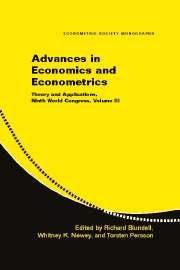Book contents
- Frontmatter
- Contents
- Contributors
- Introduction by the Editors
- 1 Identification of Nonadditive Structural Functions
- 2 Nonadditive Models with Endogenous Regressors
- 3 Heterogeneity and Microeconometrics Modeling
- 4 Heterogeneous Choice
- 5 Modeling Heterogeneity
- 6 Inference with Weak Instruments
- 7 Empirical Likelihood Methods in Econometrics: Theory and Practice
- 8 Weak Instruments and Empirical Likelihood: A Discussion of the Papers by D. W. K. Andrews, J. H. Stock, and Y. Kitamura
- 9 Estimating Continuous-Time Models with Discretely Sampled Data
- 10 Variation, Jumps, and High-Frequency Data in Financial Econometrics
- 11 Discussion of Aït-Sahalia and Barndorff-Nielsen and Shephard
- 12 Understanding Bias in Nonlinear Panel Models: Some Recent Developments
- 13 Fixed and Random Effects in Nonlinear Panel Data Model: A Discussion of a Paper by Manuel Arellano and Jinyong Hahn
- Index
- Titles in the series
5 - Modeling Heterogeneity
Published online by Cambridge University Press: 05 January 2013
- Frontmatter
- Contents
- Contributors
- Introduction by the Editors
- 1 Identification of Nonadditive Structural Functions
- 2 Nonadditive Models with Endogenous Regressors
- 3 Heterogeneity and Microeconometrics Modeling
- 4 Heterogeneous Choice
- 5 Modeling Heterogeneity
- 6 Inference with Weak Instruments
- 7 Empirical Likelihood Methods in Econometrics: Theory and Practice
- 8 Weak Instruments and Empirical Likelihood: A Discussion of the Papers by D. W. K. Andrews, J. H. Stock, and Y. Kitamura
- 9 Estimating Continuous-Time Models with Discretely Sampled Data
- 10 Variation, Jumps, and High-Frequency Data in Financial Econometrics
- 11 Discussion of Aït-Sahalia and Barndorff-Nielsen and Shephard
- 12 Understanding Bias in Nonlinear Panel Models: Some Recent Developments
- 13 Fixed and Random Effects in Nonlinear Panel Data Model: A Discussion of a Paper by Manuel Arellano and Jinyong Hahn
- Index
- Titles in the series
Summary
INTRODUCTION
My goal here is to provide some synthesis of recent results regarding unobserved heterogeneity in nonlinear and semiparametric models, using as a context Matzkin (2005a) and Browning and Carro (2005), which were the papers presented in the Modeling Heterogeneity session of the 2005 Econometric Society World Meetings in London. These papers themselves consist of enormously heterogeneous content, ranging from high theory to Danish milk, which I will attempt to homogenize.
The overall theme of this literature is that, in models of individual economic agents, errors at least partly reflect unexplained heterogeneity in behavior, and hence in tastes, technologies, etc. Economic theory can imply restrictions on the structure of these errors, and in particular can generate nonadditive or nonseparable errors, which has profound implications for model specification, identification, estimation, and policy analysis.
STATISTICAL VERSUS STRUCTURAL MODELS OF HETEROGENEITY
Using one of Browning and Carro's models to fix ideas, suppose we have a sample of observations of a dependent variable Y such as a household's purchases of organic whole milk, and a vector of covariates X, such as the prices of alternative varieties of milk and demographic characteristics of the consuming household. The heterogeneity we are concerned with here is unobserved heterogeneity, specifically the behavioral variation in Y that is not explained by variation in X. By behavioral, I mean variation that primarily reflects actual differences in actions, tastes, technologies, etc., across the sampled economic agents, rather than measurement or sampling errors.
- Type
- Chapter
- Information
- Advances in Economics and EconometricsTheory and Applications, Ninth World Congress, pp. 111 - 121Publisher: Cambridge University PressPrint publication year: 2007
- 2
- Cited by



